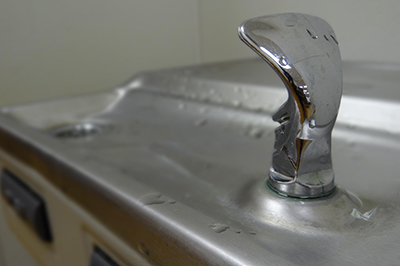By Jerome A. Paulson, MD, FAAP
E. M. Wallace makes some very appropriate points about keeping schools clean in her recent blog post Dust, Droppings, and Desperation (February 18, 2016). Schools need to protect children and employees in and around the buildings, and cleaning the buildings is one of the cornerstone activities of that fiduciary responsibility.
I was disturbed by the basic story of that blog post, and I was also very disturbed by the involvement of young adults in the cleanup process. These individuals were workers in a hazardous site. “They were met with thick layers of dust, “filth”, heavy mold and mildew, scattered dead crickets, and vermin droppings…”(Wallace, 2016). The first question is whether it is ever appropriate for children or young adults to be asked to work in a hazardous site; the second question is if it is appropriate for them to be there, were they (whether they were children, adolescents or adults) afforded the necessary personal protective equipment and processes to work in a hazardous site?
The issue of young adults (and I would add children and adults to this consideration in many situations) volunteering for cleanups goes well beyond this example. Many volunteer groups took children into Louisiana and other states for post-Katrina cleanup, and many volunteer groups go into other areas post-disaster or to do a “spring cleaning” of a riverbank or similar area. Religious groups, scouting groups, community organizations and others undertake these activities (The Connection Newspapers, 2006; Lovewell, 2007).
Child or adolescent volunteers are still in the formative part of their lives when they are more vulnerable to environmental hazards than are adults (Cohen-Hubal, et al., 2014). At this point in their lives, their brain, lungs, endocrine system and other parts of the body are still developing; therefore, they are more vulnerable to chemical, physical and biological toxicants that they can encounter in their environment.
I don’t know, but I certainly suspect that in the situation referred to by Wallace (2016) neither the volunteers nor their parents (if the volunteers had not reached the age of majority) were informed in detail about the potential hazards to be encountered at this school. Did the individuals who organized this activity have any idea as to the hazards to be encountered? How could the worker-volunteers and their parents have given consent to participate in this activity if adequate and appropriate information was, presumably, not provided?
All workers in hazardous environments should be afforded appropriate personal protective equipment (PPE) and receive adequate instructions to use that equipment appropriately (OSHA, n.d.). They need to receive training for appropriate work practices to be used in a toxic environment. Moreover, toxic materials can hitch a ride to the workers’ home and family, on their hair, skin, clothing and shoes (Zirschky, 1996; Sattler, & Davis, 2008) unless workers have PPE which they put on before entering the site and remove before returning home. Workers need to be able to leave their shoes at the worksite unless the shoes were covered by the PPE. Workers also need the opportunity to wash before eating during lunch and breaks so that they do not ingest toxic materials with their food.
I am very concerned that individuals, particularly those involved in organizing these types of activities, get caught up in the do-good, feel-good aspects of the projects and how these types of activities "build character" and "teach compassion" and fulfill community service or religious goals. While all of that may be true, these same individuals do not consider the risks to which they are exposing themselves or their charges. Organizers have a responsibility not to put volunteers in harm’s way. This is particularly true for child and adolescent volunteers who may not have the judgment to remove themselves from the activity either because they don’t perceive the danger or are too concerned with “going against the flow” of what their friends and supervisors are doing. The organizers need to fully consider the potential risks of having volunteers, particularly children and adolescents, work in these settings as well as the benefits. I, for one, think that the risks, in some instances, outweigh the benefits. Children and adolescents should not be used as a source of free labor, nor should children and adolescents be on cleanup crews in hazardous sites.
References
Cohen-Hubal, EA, et al. (2014). Identifying important life stages for monitoring and assessing risks from exposures to environmental contaminants- Results of a World Health Organization Review. Regulatory Toxicology and Pharmacology. 69, 113-124
The Connection Newspapers. (2006). Scouts help in Katrina cleanup Boy Scout Troop 160 of Chantilly, Herndon lends a hand. Retrieved from http://www.connectionnewspapers.com/news/2006/aug/02/scouts-help-in-katrina-cleanup/ Accessed 18 March 2016
Lovewell, MA. (2007). Youth group at federated church returns from mission to aid New Orleans cleanup. Vineyard Gazette. Retrieved from https://vineyardgazette.com/news/2007/01/11/youth-group-federated-church-returns-mission-aid-new-orleans-cleanup#sthash.XYm5J2PN.dpuf
Occupational Safety & Health Administration (OSHA). (n.d). U.S. Department of Labor. Personal Protective Equipment. https://www.osha.gov/Publications/osha3151.html
Sattler, B., & Davis, A. D. B. (2008). Nurses' role in children's environmental health protection. Pediatric Nursing, 34(4), 329.
Wallace, EM. (2016). Dust, Droppings, and Desperation. Educational Facilities Clearing House. Retrieved from http://www.efc.gwu.edu//library/efc-blog/dust-droppings-and-desperation/
Zirschky, J. (1996). Take-home toxin pathway. Journal of Environmental Engineering, 122, 430-436.
Jerome A. Paulson, MD, FAAP is Emeritus Professor of Pediatrics at the George Washington University School of Medicine & Health Sciences and Emeritus Professor of Environmental & Occupational Health at the Milken Institute School of Public Health at GWU. He currently serves as a consultant to the American Academy of Pediatrics, the Healthy Schools Network and others on issues pertaining to children’s health and the environment.









